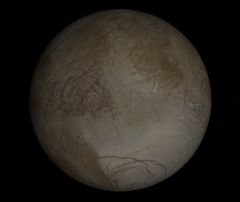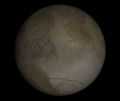Difference between revisions of "Ophelia"
(Ophelia.) Tag: Removed redirect |
(Ophelia.) |
||
| Line 16: | Line 16: | ||
|width="30%"|Epoch||align="right" width="50%"|1979.999 | |width="30%"|Epoch||align="right" width="50%"|1979.999 | ||
|- | |- | ||
| − | |width="30%"|Semimajor axis (a)||align="right" width="50%"| | + | |width="30%"|Semimajor axis (a)||align="right" width="50%"|53760000 m |
|- | |- | ||
| − | |width="30%"|Eccentricity (e)||align="right" width="30%"|0. | + | |width="30%"|Eccentricity (e)||align="right" width="30%"|0.0099 |
|- | |- | ||
| − | |width="30%"|Inclination (i)||align="right" width="30%"|0. | + | |width="30%"|Inclination (i)||align="right" width="30%"|0.1031324031° <br> (0.0018 radian) |
|- | |- | ||
| − | |width="30%"|Longitude of the ascending node (LAN, ☊)||align="right" width="30%"| | + | |width="30%"|Longitude of the ascending node (LAN, ☊)||align="right" width="30%"|164.0492759° <br> (2.8632 radian) |
|- | |- | ||
| − | |width="30%"|Longitude of periapsis (ϖ)||align="right" width="30%"| | + | |width="30%"|Longitude of periapsis (ϖ)||align="right" width="30%"|181.8109676° <br> (3.1732 radian) |
|- | |- | ||
| − | |width="30%"|Mean longitude (L)||align="right" width="30%"| | + | |width="30%"|Mean longitude (L)||align="right" width="30%"|298.0698338° <br> (5.2023 radian) |
|- | |- | ||
!bgcolor="lightsteelblue" colspan="2"|Selected physical parameters | !bgcolor="lightsteelblue" colspan="2"|Selected physical parameters | ||
|- | |- | ||
| − | |width="30%"|Mean radius||align="right" width="30%"| | + | |width="30%"|Mean radius||align="right" width="30%"|7971 m |
|- | |- | ||
| − | |width="30%"|Mass||align="right" width="30%"|1. | + | |width="30%"|Mass||align="right" width="30%"|1.692×10<sup>16</sup> kg |
|- | |- | ||
| − | |width="30%"|SidRotPeriod||align="right" width="30%"| | + | |width="30%"|SidRotPeriod||align="right" width="30%"|32486.4 (9.024 hours) |
|- | |- | ||
|width="30%"|SidRotOffset||align="right" width="30%"|0 | |width="30%"|SidRotOffset||align="right" width="30%"|0 | ||
| Line 45: | Line 45: | ||
|} | |} | ||
| − | '''Ophelia (Uranus | + | '''Ophelia (Uranus VII, S/1986 U 8)''' is one of the inner satellites of [[Uranus]]. It was discovered by the [[w:Voyager 2|Voyager2]] spacecraft in January 1986. It is named after the daughter of Polonius in [[w:William Shakespeare|Shakespeare's]] [[w:Hamlet|Hamlet]]. |
== Ophelia in Orbiter == | == Ophelia in Orbiter == | ||
| − | + | Ophelia was first introduced into Orbiter with the add-on ''uranus.zip'' in November 2002. | |
{|class="wikitable sortable” style="text-align: center" | {|class="wikitable sortable” style="text-align: center" | ||
| Line 61: | Line 61: | ||
<gallery> | <gallery> | ||
Ophelia-uranuszip.jpg|<center>Ophelia from ''uranus.zip'' in Orbiter 2002</center> | Ophelia-uranuszip.jpg|<center>Ophelia from ''uranus.zip'' in Orbiter 2002</center> | ||
| − | + | Opheliamoon.png|<center>Ophelia as seen by [[w:Voyager 2|Voyager 2]]. The elongated appearance was due to the speed of Voyager as compared to Ophelia,<br>from Wikimedia Commons</center> | |
</gallery> | </gallery> | ||
Revision as of 11:42, 11 August 2024
Ophelia (Uranus VII, S/1986 U 8) is one of the inner satellites of Uranus. It was discovered by the Voyager2 spacecraft in January 1986. It is named after the daughter of Polonius in Shakespeare's Hamlet.
Ophelia in Orbiter
Ophelia was first introduced into Orbiter with the add-on uranus.zip in November 2002.
| Add-on | Source | Version | Author | Type | Release Date | Compatibility | Wiki article |
|---|---|---|---|---|---|---|---|
| Uranus | AVSIM | Rolf Keibel | Scenery | 5 November 2002 | |||
Ophelia as seen by Voyager 2. The elongated appearance was due to the speed of Voyager as compared to Ophelia,
from Wikimedia Commons
| Uranus's natural satellites |
|---|
| Named Satellites:
Ariel | Belinda | Bianca | Caliban | Cordelia | Cressida | Cupid | Desdemona | Ferdinand | Francisco | Juliet | Mab | Margaret | Miranda | Oberon | Ophelia | Perdita | Portia | Prospero | Puck | Rosalind | Setebos | Stephano | Sycorax | Titania | Trinculo | Umbriel Numbered Satellites: |
| See also: Pronunciation key | rings of Uranus |
| edit The Solar System | |
|---|---|
| Central star |
Sun (Sol) |
| Planets |
Mercury - Venus - Earth - Mars - Jupiter - Saturn - Uranus - Neptune |
| Natural satellites |
Moon - Phobos - Deimos - Io - Europa - Ganymede - Titan - more... |
| Add-ons |
Planets - Dwarf Planets - Small objects - Natural satellites - Alternative star systems |
 | This natural satellite related article is a stub. You can help Orbiterwiki by expanding it.
|


